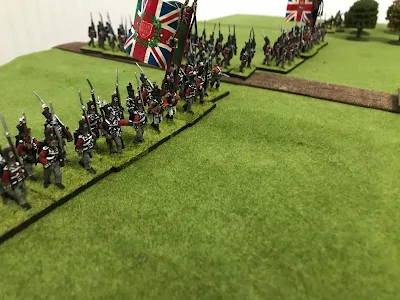Set up: The American encampment was behind a long ridge line. In addition a shallow creek was in front of the ridge. A rail fence was along the ridge that gave cover to troops behind it. One regiment was placed in front of the ridge as an advanced guard. Unfortunately they were asleep. The rest if the American army was asleep in their encampment areas (marked by rough ground) behind the ridge or in the case of the artillery off to the side of their guns. Woods covered both flanks. Once alarmed the Americans will roll to wake the regiments and respond to the attack. There are six American regiments and two guns.
The attacking British and Natives enter the board and advance towards the American lines. There are two line regiments, a combined flank battalion and a small warband of native warriors.
Turns 1 & 2: The Americans roll a "5" so they continue to sleep soundly. The British advance forward. On turn 2 they roll a "4" so they continue their rest.
Turns 3 & 4: the Alarm is sounded! Americans roll to activate. Indivual stands more forward towards the danger. One of the American guns is manned, the other not. Stands in range fire! No hits (really poor die rolling here!). Infantry rolls one dice per stand (or one dice per 2 indians) with a six a hit. Artillery roll one dice and half the number rolled rounded down are hits.
The British 8th regiment charges the advanced American Regiment. The Native warband also attacks. Since all American stands are not activeated they first test morale with a negative 2 per die roll. The American regiment is soundly defeated and retreats. (note: In close combat you roll one dice. A 1,2 the British withdraw, 5,6 American withdraw otherwise continue. I then fight another round until one side is beaten).
The combined flank battalion races up the road to engage the American guns. They take three hits on two stands which withdraw due to poor morale ( if a stand takes a hit through fire it tests morale).
Turns 5 & 6:
More American stands activate and head towards the battle. They attempt to form a line to drive off the attackers. There is lots of fire back and firth but very few hits. (Stands when they are withdrawing check morale. If they pass they return to the fight. If not they continue withdrawing but subtract from roll. This is bad and causes them to rout off board).
Flank battalion captures the two guns!
Turn 7:
The 8th regiment is locked in close combat with an equal number of Americans. It's a back and forth action with stands withdrawing and finally the American line breaks. In the center the Flank battalion also drives back the stands in front if it.
And in the woods the Native warriors chase the enemy from the woods.
Turn 8: American numbers are starting to tell. Fresh stands are forming into lines. The 8th regiment is driven back. More re American stands move up to engage the 49th and Frank battalion. At this point the British side decided to start a withdrawal taking the captured cannon with them. They have blooded the invader and captured their artillery and with few casualties. The American army has seen the attackers off but now must decide if they should continue the advance through the country.
Conclusion:
I have played this now about four times. It is always a fast game. If the Americans can get an early warning it speeds up their activation and gives them more time to bring up stands. Eventually, as in the historical battle numbers tell and the British withdraw. But until then its a series of individual actions and you see how much damage they can do. There are a lot of Americans and only half as many British. But the game dies give a goid feeling for the actual battle and the results are also similar.
All in all it's a fast fun game and can be changed to almost any time period depending on what figures you have. Give it a go, you may enjoy it!





























